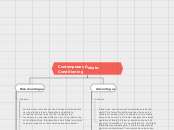Contemporary Debate- Conditioning
Disadvantages
At home:
Children can not reflect on their behaviour like adults can due to their lack of empathy and ability to verbalise their feelings. So the 'naughty step' technique is not always effective as it can lead to the child internalising their emotions which has long-term negative impacts on their emotional development.
When conditioning their kids, parents need to be calm and consistent. For a full time parent it can be very difficult to not get stressed and frustrated which would mean the conditioning effects would be worse than promised.
In School
The use of a reward punishment system in schools could take away a child's natural desire to learn
Lepper et al. (1973) researched the effort children put into drawing a picture when they were offered a reward and when not. He found that the kids spent more time on their pictures when they were not motivated by rewards.
This can lead to 'learned helplessness'
Dweck (1975) compared two groups of children; one group had been praised for good work on a maths test and the other had not. The group that had not been rewarded ended up putting less work into future tests.
Reward systems are not used in different cultures around the world.
Lewis (1995) found students from a Japanese elementary school were internally motivated and got very high grades.
Peers
Peer groups influence children
Bricker et al. (2006) found children as young as 10 years old were more likely to try smoking if one of their friends have. (bgfbgfg2006)
Vulnerable groups of children
The Lovaas technique is mainly supported by Lovaas's own research which means the effectiveness may not be entirely valid. Also, it is indicated that the treatment needs to be very intensive but Anderson et al. (1987) found 20 hours is enough contact to see significant improvement
Conditioning techniques only treat the symptoms so undesirable behaviour may re-emerge later in life
Advantages
At Home
It has been used in most households across the world. This form of conditioning may be seen as outdated, however it has changed a considerable amount. At home if a child was naughty the parent would most likely hit them or cause some sort of physical stimulation. This would teach the child that that behaviour equals pain. This is an example of positive reinforcement. Techniques have become more and more ethical to the point where children are asked to just sit on a step for a period of time, and its proven to be just as effective.
In school
Education has been a major user of operant conditioning to control the children. Gold stars, merits and house points are positive reinforcers, they use these to reward good behaviour. McAllister et al. did a study in a classroom and found that in a room with a rewarding teacher and who also punishes bad behaviour, the negative behaviour in the room decreased heavily. Le Francois (2000) suggests that classical conditioning can be used to improve student performance by increasing the number of pleasant stimuli in the room.
Peers
Our peers start to have more of an influence when we join education even from a young age like nursery or early years. By praising and rewarding children the other peers learn from them and reciprocate the good behaviours.
Vulnerable groups of children
Psychologists will use conditioning techniques with various psychological and medical conditions. Lovaas (1987) developed applied behaviour analysis (ABA) to increase the frequency and quality of social interactions for children with autistic spectrum disorder. During therapy children are rewarded for most behaviours and overtime they are reduced to refine the desired behaviours.
Robinson et al. (1981) showed how the use of token economies can improve performance in reading and vocabulary related tasks of children with hyperactivity issues. This means they collect tokens for desirable behaviour, which will then be available to cash in for rewards.
Chaney et al. (2004) used the idea of a "funhaler" with children with asthma, basically an inhaler which is fun to use. After a few weeks of using it parents repoerted that their children responded better and had fewer behaviour problems.
